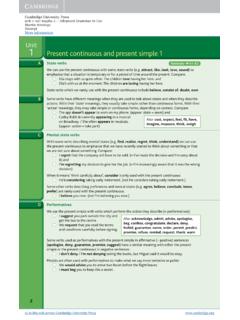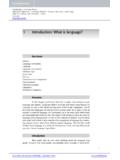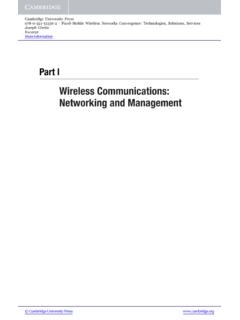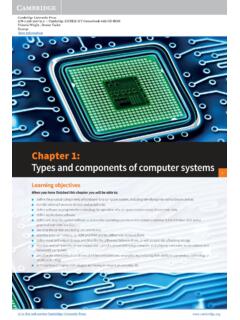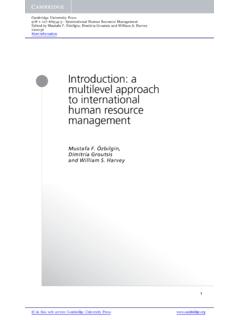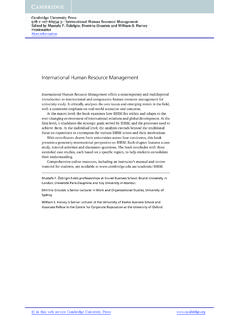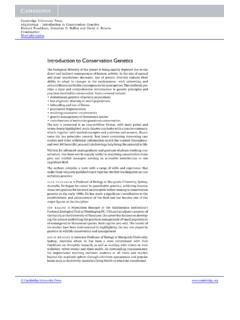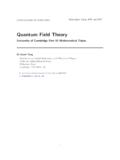Transcription of Quality Concepts - Cambridge University Press
1 1 Quality IntroductionQuality is perceived differently by different people. Yet, everyone understands whatis meant by Quality . In a manufactured product, the customer as a user recognizesthe Quality of fit, finish, appearance, function, and performance. The Quality of ser-vice may be rated based on the degree of satisfaction by the customer receiving theservice. The relevant dictionary meaning of Quality is the degree of excellence. However, this definition is relative in nature. The ultimate test in this evaluationprocess lies with the consumer. The customer s needs must be translated into mea-surable characteristics in a product or service. Once the specifications are developed,ways to measure and monitor the characteristics need to be found. This provides thebasis for continuous improvement in the product or service. The ultimate aim is toensure that the customer will be satisfied to pay for the product or service.
2 Thisshould result in a reasonable profit for the producer or the service provider. Therelationship with a customer is a lasting one. The reliability of a product plays animportant role in developing this Quality and Reliability DefinedThere are many definitions of Quality available in the literature. A definitionattributed to Quality guru Crosby states the following: Quality is conformance to preceding definition assumes that the specifications and requirements havealready been developed. The next thing to look for is conformance to these require-ments. Another frequently used definition comes from Juran: Quality is fitness for Cambridge University University Press978-0-521-51522-1 - Quality and Reliability in EngineeringTirupathi R. ChandrupatlaExcerptMore information2 Quality ConceptsThis definition stresses the importance of the customer who will use the Edwards Deming defined Quality as follows:Good Quality means a predictable degree of uniformity and dependabilitywith a Quality standard suited to the underlying philosophy of all definitions is the same consistency of confor-mance and performance, and keeping the customer in definition that is widely accepted isQuality is the degree to which performance meets definition provides a means to assess Quality using a relative provide here the definition adopted by the American Society for Quality (ASQ).
3 Quality denotes an excellence in goods and services, especially to thedegree they conform to requirements and satisfy definition assimilates the previous ones and is our definition of implies dependability reliability introduces the concept of failureand time to failure:Reliability is the probability that a system or component can perform itsintended function for a specified interval under stated and reliability go hand in hand. The customer expects a product of goodquality that performs Historical DevelopmentThe history of Quality is as old as civilization. The Harappans of the ancient IndusValley civilization (3000bc) achieved high precision in the measurement of length,mass, and time. The smallest division, which is marked on an ivory scale fromLothal, was approximately millimeters, recorded in the Bronze Age. Thedimensions of the pyramids, built around 2500bc, show a high degree of , the use of tolerancing systems for the specification of Quality and statis-tical principles to monitor Quality are of recent origin.
4 The Quality movement maybe traced back to medieval Europe. Craftsmen began organizing into unions calledguilds in the late thirteenth century. Manufacturing in the industrialized world fol-lowed the craftsmanship model throughout the eighteenth century. The factory sys-tem, with its emphasis on product inspection, started in Great Britain in the mid-1750s and grew into the Industrial Revolution in the early nineteenth century. In1798 Eli Whitney introduced the concept of producing interchangeable parts to sim-plify assembly. Cambridge University University Press978-0-521-51522-1 - Quality and Reliability in EngineeringTirupathi R. ChandrupatlaExcerptMore Quality Philosophies3 Objective methods of measuring and ensuring dimensional consistency evolvedin the mid-1800s with the introduction of go gages. A go gage for a hole checks for itslower limit (maximum material condition).
5 No-go gages, which are used to check theupper limit for a hole, were introduced much later. Frederick W. Taylor introducedthe principles of scientific management around 1900 and emphasized the divisionof labor with a focus on productivity. There was a significant rise in productivitybut it had a negative effect on Quality . Henry Ford s moving automobile assemblyline was introduced in 1913. This required that consistently good- Quality parts wereavailable so that the production assembly line would not be forced to slow down. In1924 Walter A. Shewhart introduced the basic ideas of the statistical process controlchart, which signaled the beginning of the era of statistical Quality control. By themid-1930s, statistical Quality control methods were widely used at Western Electric,a manufacturing arm of the Bell War II brought increased recognition of Quality in manufacturing indus-tries and military applications.
6 The American Society for Quality Control wasformed in 1946. (Eventually it shortened its name to ASQ in 1997.) A qual-ity revolution in Japan followed World War II: the Japanese began applying thelessons learned in producing military goods produced for export. Quality stalwartsW. Edwards Deming and Joseph M. Juran lectured extensively in Japan. As aresult, the Japanese became leaders in Quality by the 1970s. Japanese manufactur-ers began increasing their share in American markets, resulting in widespread eco-nomic effects in the United States. The response emphasized not only statisticsbut approaches that embraced the entire organization a movement that becameknown as Total Quality Management. Several other Quality initiatives followed. TheISO 9000 Quality system standards were published in 1987. The Baldrige NationalQuality Program and the Malcolm Baldrige National Quality Award were estab-lished by the Congress in the same year.
7 The Quality philosophies that intro-duced the modern Concepts of Quality are presented in the next Quality PhilosophiesSeveral individuals made significant contributions to Quality control and improve-ment. We take a closer look at the approach and philosophies of W. EdwardsDeming, Joseph M. Juran, Philip B. Crosby, and Armand V. Edwards DemingW. Edwards Deming is perhaps the best-known Quality expert in the world. He wasinstrumental in the post-war industrial revival of Japan. Subsequently his ideas wereincreasingly adopted in industry in the United States and other countries. Dem-ing received his electrical engineering degree from the University of Wyoming and Cambridge University University Press978-0-521-51522-1 - Quality and Reliability in EngineeringTirupathi R. ChandrupatlaExcerptMore information4 Quality Conceptshis in mathematical physics.
8 He worked for the Western Electric Companywith Walter A. Shewhart, the developer of the control chart. Deming then workedwith the Department of Agriculture and the Census Bureau. Starting in1950 he delivered a series of lectures to top management in Japan on statistical pro-cess control. Japanese industry adopted his methods which resulted in a significantimprovement in Quality . Deming firmly believed that Quality is the responsibility ofthe management. The Deming philosophy is summarized in the following fourteenpoints,1which were included in his monumental workOut of the fourteen points apply to both small and large organizations, to the serviceindustry as well as to manufacturing. They also apply to a division within a fourteen points are presented constancy of purpose for improvement of product and stresses the need for a mission statement which must be understood by allemployees, suppliers, and customers.
9 The strategic plan should look for the long-term the new must learn the responsibilities andtake on leadership for change. Poor workmanship, defective products, or bad serviceare not dependence on mass the need for inspection on amass basis by building Quality into the product in the first place. Statistical methodsof Quality control are more the practice of awarding business on the basis of price tag ,minimize the total cost. The aim in the purchase of new tools and other equipmentshould be to minimize the net cost per hour of operation or per piece toward a single supplier for any one item, on a long-term relationship of loy-alty and constantly and forever the system of production and of product and service is an ongoing process. The Deming cycleinvolves the four-step process of plan, do, check, act. At theplanstage, the oppor-tunities for improvement are identified.
10 The theory is tested on a small scale at thedostage, the results of the test are analyzed at thecheckstage, and the results areimplemented in training must be provided for all must be encouraged to implement the knowledge developed and institute aim of supervision should be to helppeople to do a better job using machines. Supervision must create an environmentwhere the workers take leadership roles in accomplishing their , W. Edwards,Out of the Crisis, pp. 23 24,c 2000, Massachusetts Institute of Technology,by permission of the MIT Press . Cambridge University University Press978-0-521-51522-1 - Quality and Reliability in EngineeringTirupathi R. ChandrupatlaExcerptMore Quality out must create an environment where workers areencouraged to ask questions and make suggestions. A climate of innovation leadsto down barriers between in research, design, mate-rial procurement, sales, and production must work as a team.
